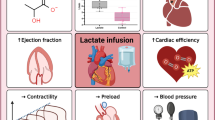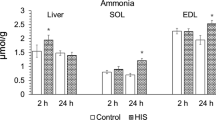Summary
In the present investigation the effect of elevated arterial free fatty acid (FFA) concentrations on regional myocardial blood flow (MBF), myocardial metabolism and hemodynamics during ischemia was studied in anesthetized dogs.
Ischemia was induced by stenosis of the left interventricular coronary artery. Mean poststenotic coronary artery pressure was kept constant during ischemia. FFA concentrations were elevated by intravenous injection of heparin (group I), intralipid (group II) or both substances (group III).
After elevation of FFA concentrations by heparin alone or together with intralipid, heart rate gradually increased, while aortic pressure tended to decrease.
Slight elevation of arterial FFA levels (up to 0.30 mM, group I, and up to 0.53 mM, group II) had no significant effect on total MBF and uptake of glucose, FFA, and oxygen or release of lactate in the ischemic myocardium. However, elevating arterial FFA levels up to 0.81 mM (Group III), significantly decreased total MBF (6%), endo/epicardial blood flow ratio (13%), and oxygen uptake (34%) in the ischemic myocardium and resulted in release of lactate from this area. The release of potassium, inorganic phosphate and H+ as well as plasma CO2 concentration were not influenced. Neither was the uptake of glucose and FFA.
These findings suggest that elevated arterial FFA concentrations can decrease MBF and augment lactate production in the ischemic myocardium.
Similar content being viewed by others
References
Blass, K.-E., P. Mentz, W. Förster: Effects of unsaturated fatty acids on canine coronary flow. Acta Biol. Med. Ger.37, 765–767 (1978).
Cane, R. D., R. A. Harrison, B. A. Shapiro, J. Kavanaugh: The spectrophotometric absorbance of intralipid. Anesthesiology53, 53–55 (1980).
Dagenais, G. R., and B. Jalbert: Effect of increased free fatty acids on myocardial oxygen extraction and angina threshold during atrial pacing. Circulation56, 315–319 (1977).
Gould, K. L., K. Lipscomb, C. Calvert: Compensatory changes of the distal coronary vascular bed during progressive coronary constriction. Circulation51, 1085–1094 (1975).
Hülsmann, W. C.: Coronary vasodilation by fatty acids. Basic Res. Cardiol.71, 179–182 (1976).
Jansen, H.: Lipolytic activities in postheparin serum. Thesis, Medical Faculty (Rotterdam, The Netherlands 1975).
Kjekshus, J. K., O. D. Mjøs: Effect of free fatty acids on myocardial function and metabolism in ischemic dog heart. J. Clin. Invest.51, 1767–1776 (1972).
Kurien, V. A., M. F. Oliver: Serum free fatty acids after acute myocardial infarction and cerebral vascular occulusion. The Lancet1966/II, 122–127.
De Leiris, J., L. H. Opie, W. F. Lubbe: Effect of free fatty acid and enzyme release in experimental glucose on myocardial infarction. Nature253, 746–747 (1975).
Marsboom, R. A., D. Verstraete, D. Thienpont, D. Mattheeuws: The use of haloanisone and fentanyl for neuroleptanalgesia in dogs. Br. Vet. J.120, 466–468 (1964).
Mjøs, O. D.: Effect of free fatty acids on myocardial function and oxygen consumption in intact dogs. J. Clin. Invest.50, 1386–1389 (1971).
Mjøs, O. D.: Free fatty acids and oxygen consumption in dogs. Scand. J. Clin. Lab. Invest.28, 121–125 (1971).
Most, A. S., M. H. Lipsky, P. A. Szydlik, C. Bruno: Failure of free fatty acids to influence myocardial oxygen consumption in the intact anesthetized dog. Cardiology58, 220–228 (1973).
Nelson, P. G.: Free fatty acids and cardiac arrhythmias. The Lancet1970/I, 783.
Nelson, P. G.: Effect of heparin on serum free fatty acids, plasma catecholamines, and the incidence of arrhythmias following acute myocardial infarction. Brit. Med. J.1970/3, 735–737.
Oliver, M. F., V. A. Kurien, T. W. Greenwood: Relation between serum free fatty acids and arrhythmias and death after acute myocardial infarction. The Lancet1968/I, 710–715.
Oliver, M. F., P. A. Yates: Induction of ventricular arrhythmias by elevation of arterial free fatty acids in experimental myocardial infarction. Cardiology,56, 359–364 (1971).
Opie, L. H., M. Thomas, P. Owen, R. M. Norris, A. J. Holland, S. Van Noorden: Failure of high concentrations of circulating free fatty acids to provoke arrhythmias in experimental myocardial infarction. The Lancet1971/I, 818–822.
Opie, L. H., P. Owen, R. A. Riemersma: Relative rates of oxidation of glucose and free fatty acids by ischemic and non-ischemic myocardium after coronary artery ligation in the dog. Eur. J. Clin. Invest.3, 419–435 (1973).
Owen, P., M. Thomas, V. Young, L. H. Opie: Comparison between metabolic changes in local venous and coronary sinus blood after acute experimental coronary arterial occlusion. Am. J. Cardiol.25, 562–570 (1970).
Riemersma, R. A., R. L. Logan, M. F. Russell, M. F. Oliver: Heparin, free fatty acids and myocardial infarction in man. J. Mol. Cell. Cardiol.9, suppl., 45 (abstract) (1977).
Riemersma, R. A., R. L. Logan, M. F. Oliver: Intralipid-heparin in metabolic studies and in-vitro lipolysis. J. Mol. Cell. Cardiol.9, suppl. 45–46 (abstract) (1977).
Riemersma, R. A., M. F. Oliver: Raised plasma free fatty acids (FFA), ischemic myocardial metabolism and arrhythmias. J. Mol. Cell. Cardiol.11, suppl. 2, 48 (abstract) (1979).
Rognoni, F., V. Vigano: Experimental research on metabolic effects of heparin and myocardial activity. Artery3, 180–187 (1977).
Russo, J. V., S. Margolis, O. C. Friesinger, R. S. Ross: Heparin and ventricular arrhythmias after myocardial infarction. The Lancet1970/II, 1271–1275.
Rutenberg, H., J. C. Pamintuan, L. A. Soloff: Serum free fatty acids and their relation to complications after acute myocardial infarction. The Lancet1969/II, 559–564.
Schaper, W. K. A., P. Lewi, A. H. M. Jageneau: The determinants of the rate of change of the left ventricular pressure (dP/dt). Arch. Kreislaufforsch.46, 27–41 (1965).
Schosser, R., K.-E. Arfors, K. Messmer: MIC II: a program for the determinants of cardiac output, arterio-venous shunt and regional blood flow using the radioactive microsphere method. Comput. Progr. Biomed.9, 19–39 (1979).
Snoeckx, L. H., J. L. Verheyen, A. Van de Water, P. Lewi, R. S. Reneman: Online computation of cardiac output with the thermodilution method using a digital minicomputer. Cardiovasc. Res.10, 556–564 (1976).
Spitzer, J. J.: Effect of lactate infusion on canine myocardial free fatty acid metabolism in vivo. Amer. J. Physiol.226, 213–217 (1974).
Takano, S.: Genetic studies on the arrhythmia in acute myocardial infarction with special reference to serum free fatty acid level. Japan. Circ. J.40, 287–297 (1976).
Van der Meer, J. J., R. S. Reneman: An improved technique to induce a standardized functional stenosis of a coronary artery. Europ. Surg. Res.4, 407–418 (1972).
Van der Vusse, G. J., F. W. Prinzen, W. A. Coumans, R. Kruger, C. Verlaan, R. S. Reneman: Assessment of myocardial ischemia using hemodynamic and biochemical variables with special reference to elevated arterial free fatty acid concentration by heparin. In: Adv. Clin. Cardiol.1, 407–420 (Eds.: Kreuzer, H., W. W. Parmley, H. W. Heiss, P. Rentrop) G. Witstrock Publishing House Inc., New York (1980).
Yamazaki, N., Y. Suzuki, T. Kamikawa, K. Ogawa, K. Mizutani, K. Kakizawa, M. Yamamoto: Arrhythmogenic effects of acute free fatty acid mobilization on ischemic heart. Recent Adv. Stud. Cardiac Struct. Metab.12, 271–277 (1978).
Author information
Authors and Affiliations
Additional information
With 2 figures and 4 tables
The investigations were (partly) supported by the Foundation for Medical Research FUNGO, which is subsidized by the Netherlands Organization for the Advancement of Pure Research (ZWO).
Rights and permissions
About this article
Cite this article
Prinzen, F.W., van der Vusse, G.J., Coumans, W.A. et al. The effect of elevated arterial free fatty acid concentrations on hemodynamics and myocardial metabolism and blood flow during ischemia. Basic Res Cardiol 76, 197–210 (1981). https://doi.org/10.1007/BF01907958
Received:
Issue Date:
DOI: https://doi.org/10.1007/BF01907958




